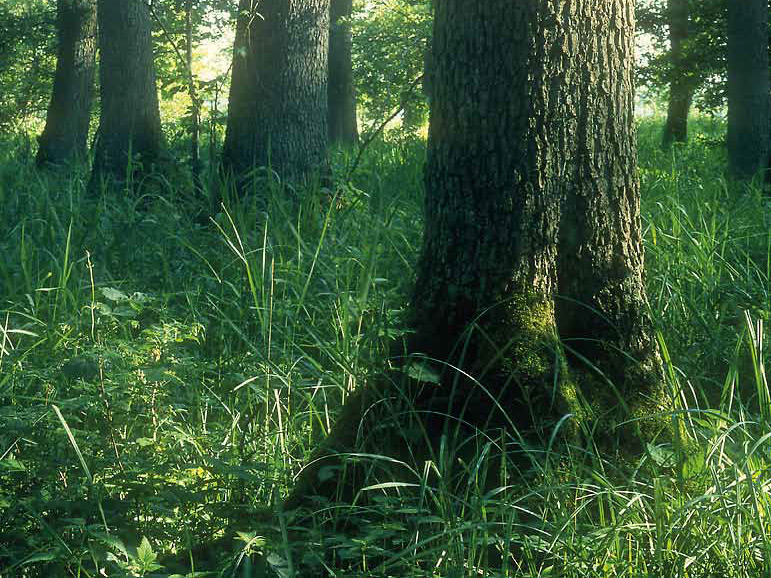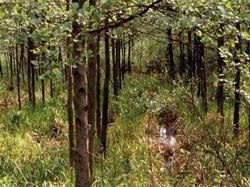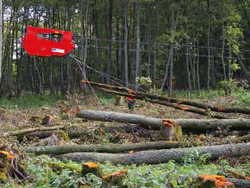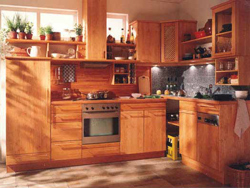Black alder (Alnus glutinosa)
In brief
Black alder, also called red alder, is a native deciduous tree species with high light requirements, very rapid juvenile growth, and a life span of about 120 years. Alder forests often form pure stands and were widespread before peatland cultivation declined.
Alder is well adapted to wet sites. The lenticels (pores) at the base of the trunk ensure adequate oxygen supply to the roots even when groundwater levels are high. Alder has high nutrient requirements but can generate nitrogen through symbiotic relationships with bacteria residing on the roots. It performs best on moist to moderately moist sites with a good nutrient supply. Still though, satisfactory growth can be expected under semi-wet conditions (forest O2 sites; 4+). Sites with persistently high groundwater (silvicultural O1 sites; 4+/5+) are no longer profitable for alder cultivation.
Flyer "Black alder fact sheet"
Water level: 0-20 cm below surface
Water level category: 4+; forestry O.2 sites
Establishment: Depends on type of operation, either planting and/ or coppicing.
Yield: In timber operation 4-6 harvests within 60-80 years with a total growth of about 600-800 m³ per hectare. In coppice forest 1 - 3 harvests within 20-40 years with a total growth capacity of 200-500 m³ per hectare.
Uses: For lumber or energy production.
Emission reduction: Approx. 18 t CO2-eq. per hectare and year (compared to nutrient-rich, drained coppice, without emission reduction through replacement of fossil fuel based raw materials).
Potential
To produce timber, peatland sites without year-round and complete water saturation are particularly suitable. When cultivating alder in semi-wet sites, the peat body can be conserved and, in some cases, a positive carbon balance can be achieved. On these areas, alder can be grown for timber, or in a coppice operation for energy production.
Timber production

The production period of alder timber is 60-80 years, since older stands degrade due to stem rot. The objective is to achieve a trunk diameter at chest height of >45 cm for valuable timber. The total growth capacity up to age 60 is 600 -800 m³ per hectare in the I. yield class.
Stand establishment
Two-year-old staked plants with a size of 80 - 120 cm are recommended for production. Per hectare, 3,000 -3,500 seedlings are planted with a row spacing of 2 x 2 m. On wet soils, planting is done on artificially created soil mounds. It is important that plants have a suitable origin and observe the Forest Reproductive Material Act in Germany (Forstvermehrungsgutgesetz - FoVG).
Care
Up to the age of approximately 10 years, young growth should be maintained, however, only particularly badly formed young growth should be removed. The most important maintenance phase is while stands are young (age 10 - 25 years). During this time, up to 120 high-quality trees per hectare should be selected (particularly vigorous trees of good quality). Once the tree truck reaches 6 m, these trees are encouraged by repeated thinning (2-3 rounds).
Alder in coppice

The rotation period in coppice forest is 20 -40 (60) years. The goal is to produce as much wood as possible, usually for energy production. The total growth capacity up to age 30 is about 400 m³ per hectare. After harvesting, regeneration of the stand takes place through shoot cuttings.
Stand establishment
To be profitable, about 500 shoots per hectare are needed. After cutting shoots 3 – 4 times, the trees begin to lose their ability to regenerate, so it is necessary to constantly replace them by planting.
Maintenance
Shoots greater than approx. 10 cm should be removed and only 2-3 shoots should be left.
Timber harvesting

Final harvesting is mostly done by splitting (strips up to approx. 60 m wide) or hole cutting (holes 0.3 -0.5 ha in size). Logging is carried out by motorized or mechanical means (e.g., caterpillar harvesters). For mechanical logging, caterpillar harvester or cable crane technology is used. If possible, trees should be felled during the period of lowest groundwater level. Old and dead wood should be remain on site where possible.
Utilization

Material utilization
The reddish wood of the alder (also called red alder) is soft and has a uniform, fine structure. It is light and very durable under water. The best quality logs produced in timber operations are marketed as veneer logs. Good to normal quality wood, in addition to various special uses, is mainly sold as sawlogs for solid furniture and interior finishing. Soft wood from thinning is in demand to produce chipboard, fiberboard, and OSB boards.
Heat generation
Alder wood produced by coppicing is suitable for use as firewood in the form of logs or chips. With a comparatively long production period of 30 to 40 years, the production of soft wood for material use can also be a priority. Alder coppice is most productive compared to other coppice types (e.g., oak coppice). Coppice can also be a viable use on sites that are waterlogged year-round and are not profitable for timber operations.
Sources & Further Information
- Röhe, P. & Schröder, J. (2010) Grundlagen und Empfehlungen für eine nachhaltige Bewirtschaftung
der Roterle in MV. Schwerin, 49 S. - Schäfer, A. & Joosten, H. (2005) Erlenaufforstung auf wiedervernässten Niedermooren
ALNUS Leitfaden. DUENE, 68 S. - Sündermann & Röhe (2014) Vollmechanisierte Holzernteverfahren auf Nassstandorten.
Landesforst Mecklenburg-Vorpommern, Malchin. 35 S. - Sündermann, J., Schröder, J. & Röhe, P. (2013) Bodenschonende Holzernte in geschädigten
Eschenbeständen auf Nassstandorten Erkenntnisse und Empfehlungen aus Fallstudien in Mecklenburg-
Vorpommern. Schwerin: Ministerium für Landwirtschaft, Umwelt und Verbraucherschutz Mecklenburg-
Vorpommern (LU). 44 S. - Flyer "Steckbrief Schwarz-Erle"












